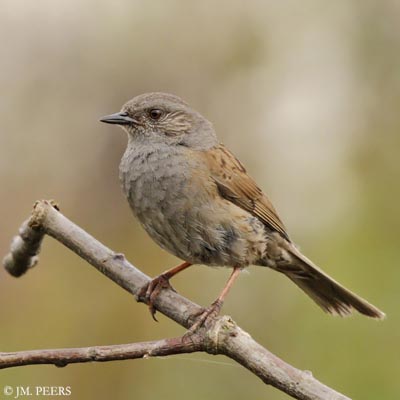
Dunnock
Prunella modularis
Passeriforme Order – Prunellidae Family
BIOMETRICS:
Length : 14-15 cm
Wingspan : 19-21 cm
Weight : 16-25 g
LONGEVITY: Up to 8 years
DESCRIPTION:
Dunnock is a common species, relatively similar to the House Sparrow. Both birds are often confused.
Dunnock is also known as Hedge Sparrow and Hedge Accentor.

Adult male has brown upperparts streaked pale and darker brown on mantle and rump. Wings and tail are dark brown. It has thin buff wing bar.
Underparts are blue-grey, except the brownish flanks streaked dark brown. Underwing is blue-grey too.
On the head, forehead and crown are brown streaked dark brown, joining the mantle. Face is blue-grey with brown cheeks streaked dark brown. It has a conspicuous blue-grey eyebrow.
The thin bill is blackish with reddish base on lower mandible. Eyes are chestnut-brown. Legs and feet are pink.

Female is similar but slightly duller, with paler grey areas on head and underparts.

Juvenile has brown body heavily streaked blackish. Head is browner than in adults, lacking the blue-grey colours. The pale wing bar is conspicuous. Eyes are darker brown.
VOICE: SOUNDS BY XENO-CANTO
Dunnock’s typical call is a loud, persistent “seep”, and a softer trilling “ti-ti-ti-ti” often given in flight.
The song is a pleasant warble but squeaky and high-pitched. It is very similar to that of the Winter Wren, but softer, shorter and quieter. It often sings from exposed perch.

HABITAT:
Dunnock frequents gardens, hedges, forests with thick undergrowth, open areas with bushes, scrubs and parks. It may be seen from sea-level to high mountains.
RANGE:
Dunnock is mainly resident in western and southern Europe. Populations of northern and eastern parts of the range migrate to Mediterranean and Middle-East.
The species has been introduced in New Zealand and breeds throughout the country.
BEHAVIOUR:
Dunnock is often seen foraging on the ground, moving like a mouse with the body close to the ground. It often stays under low bushes and hedgerows. It may hops quickly, with flicking wings and tail.

It feeds mainly on several kinds of insects, taking them from the leaf litter or between roots. After the breeding season, it feeds on seeds and berries. It may be seen at bird-feeders.
Dunnock has complex breeding behaviour. If one male may have one, two or three females, one female may have two males. And because females are polyandrous, males have to ensure their paternity. For that, before the copulation, the male stimulates the female with its bill, in order to produce the ejection of sperm from previous mating.
After hatching, in a relation with two males for one female, one male will be subordinate and prevented from mating. In this case, it does not feed the young. The male shares the nesting duties only in proportion to its mating success. Finally, most of birds are monogamous, with normal pairs including one male and one female.
Dunnock is frequent host of Common Cuckoo (Cuculus canorus), in spite of their very different eggs.
Dunnock is often seen alone, but sometimes, flocks can be seen at food sources.
FLIGHT:
Dunnock usually moves among scrubs, rarely in open areas. But when it does, it performs direct flight with rapid wing beats and flies low from the ground.


REPRODUCTION:
Breeding season occurs in spring, starting in April.
The female builds the bulky nest in scrub, dense shrubs or hedges. Nest is cup-shaped, and made with twigs, moss, dry leaves, rootlets and varied pieces of plants. Interior is lined with moss and fur, sometimes wool and feathers too. It is situated between 1, 50 and 2 metres above the ground.
Female lays 4-5 turquoise-coloured eggs with some indistinct reddish spots. Incubation by female lasts about 12-13 days. She regularly leaves the nest for feeding during about ten minutes.
At hatching, the chicks are partially covered with blackish down. They are fed by both adults and leave the nest about 12 days later.
Male feeds the young during the last days while the female builds a new nest for the second brood, and sometimes, this species may produce three broods per season.

DIET:
Dunnock feeds mainly on seeds and small insects in autumn and winter. During the spring, it feeds primarily on insects and their larvae, spiders and small green caterpillars.
PROTECTION / THREATS / STATUS:
Dunnock’s populations are not globally threatened at this moment, but some declines were observed in late 20th century, due to changes in the habitat such as deforestation.
Populations are now recovering good numbers.
Fr: Accenteur mouchet
All: Heckenbraunelle
Esp: Acentor común
Ital: Passera scopaiola
Nd: Heggemus
Russe: Lesnaya zavirushka
Sd: Järnsparv
Photographs of adults by Jean Michel Peers
His website :
JMPN PHOTOGRAPHIE
Photographs of the juvenile and text by Nicole Bouglouan
Sources:
THE COMPLETE BOOK OF BRITISH BIRDS – Written by “Royal Society for the Protection of Birds” experts - Préface de Magnus Magnusson - Michael Cady- Rob Hume Editors - ISBN: 0749509112
THE HANDBOOK OF BIRD IDENTIFICATION FOR EUROPE AND THE WESTERN PALEARCTIC by Mark Beaman, Steve Madge - C.Helm - ISBN: 0713639601
Pájaros de España (JL Beamonte)
Wikipedia (Wikipedia, The Free Encyclopedia)